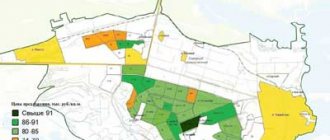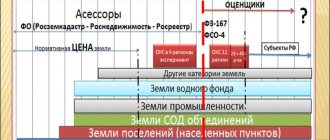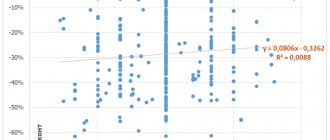Cadastral value of the property
The cadastral value of a property is established as a result of state cadastral valuation procedures, by decision of the executive body of state power of a constituent entity of the Russian Federation and is used for taxation purposes. Over the past 3 years, cadastral valuation has been fundamentally shaken. On January 1, 2020, the Federal Law “On State Cadastral Valuation” came into full force (the transition period has already passed), which offers a completely new approach and methodology for determining the cadastral value of real estate.
The changes are aimed at applying a unified cadastral valuation algorithm throughout the country. For example, previously valuation services were provided by private independent appraisers under a government contract, approved by local (or regional) authorities, and Rosreestr acted as an arbiter. Such an organization of the assessment process yielded extremely negative results.
Now a decision has been made to introduce the institution of state cadastral appraisers and transfer the powers to determine the cadastral value to state budgetary institutions that will conduct this activity on an ongoing basis. The cadastral value is calculated using the mass valuation method using the methodology of any of the approaches (cost, comparative or income) and only in exceptional cases is an individual calculation used.
Market value of the property
The market value of a property is nothing more than its most likely price when sold on the open market under real competition. Unlike the cadastral value, the market value is established not by the state, but by its owner, realtor or professional appraiser, who can be hired at the initiative of any of the parties to the transaction. Those. If you need a report on the market value of a property, just contact an appraisal organization or a private practice specialist. A mandatory requirement for an appraiser is to have current membership in the relevant SRO and insured liability, and the form of activity does not matter (individual entrepreneur or employee of a legal entity).
Another fundamental difference between cadastral value and market value is that when calculating the market value of a property, an individual method is used, versus the method of mass analysis for state cadastral valuation. Despite the fact that the approach is the same as in the first case, any one can be chosen (cost-based, comparative, profitable, etc.).
The key point is that when determining the market value of a property, the interests of the buyer and seller are equally taken into account: one is interested in selling the product at the highest possible price (to make a profit), the other seeks to purchase the product at a favorable price, preferably the minimum. Those. the price set in market conditions balances supply and demand and is a compromise between seller and buyer.
TechniquesLeave a comment | Read comments
MINISTRY OF PROPERTY RELATIONS OF THE RUSSIAN FEDERATION ORDER No. 568-r dated March 6, 2002 “ON APPROVAL OF METHODOLOGICAL RECOMMENDATIONS FOR DETERMINING THE MARKET VALUE OF LAND” (as amended by the order of the Ministry of Property of the Russian Federation dated 31.0 7.2002 No. 2314-r)
In accordance with Decree of the Government of the Russian Federation dated July 6, 2001 No. 519 “On approval of assessment standards” (Collected Legislation of the Russian Federation, 2001, No. 29, Art. 3026):
approve the attached methodological recommendations for determining the market value of land plots.
Minister F.R. GAZIZULLIN
Approved by order of the Ministry of Property of Russia dated March 6, 2002 No. 568-r
METHODOLOGICAL RECOMMENDATIONS FOR DETERMINING THE MARKET VALUE OF LAND (as amended by the order of the Ministry of Property of the Russian Federation dated July 31, 2002 No. 2314-r)
I. General provisions
These methodological recommendations for determining the market value of land plots were developed by the Ministry of Property of Russia in accordance with Decree of the Government of the Russian Federation of July 6, 2001 No. 519 “On approval of valuation standards.”
Methodological recommendations can be used to evaluate land plots (valuation objects) that have not been withdrawn from circulation, which are formed (or can be formed) in accordance with the law (hereinafter referred to as “land plots”).
II. Methodological basis for assessing the market value of land plots
Market value is given to those land plots that are capable of satisfying the needs of the user (potential user) for a certain time (the principle of utility).
The market value of a land plot depends on supply and demand in the market and the nature of competition between sellers and buyers (the principle of supply and demand).
The market value of a land plot cannot exceed the most probable costs of acquiring an object of equivalent utility (substitution principle).
The market value of a land plot depends on the expected value, duration and probability of receiving income from the land plot over a certain period of time with its most effective use, without taking into account income from other factors of production attracted to the land plot for business activities (hereinafter, for the purposes of these recommendations, land rent ) (expectation principle).
The market value of a land plot changes over time and is determined on a specific date (principle of change).
The market value of a land plot depends on changes in its intended purpose, permitted use, the rights of other persons to the land plot, and the division of property rights to the land plot.
The market value of a land plot depends on its location and the influence of external factors (the principle of external influence).
The market value of a land plot is determined based on its most effective use, that is, the most likely use of the land plot, which is physically possible, economically justified, meets legal requirements, is financially feasible and as a result of which the estimated value of the land plot will be maximum (the principle of the most effective use) . The most effective use of a land plot is determined taking into account its possible justified division into separate parts that differ in shape, type and nature of use. The best use may not be the current use of the land.
When determining the most effective use, the following are taken into account:
- intended purpose and permitted use;
- the prevailing land use methods in the immediate vicinity of the assessed land plot;
- prospects for the development of the area in which the land plot is located;
- expected changes in the land and other real estate market;
- current use of the land.
III. General guidelines for conducting assessments
It is recommended to assess the market value of land plots in accordance with the methodological principles given above.
The date of assessing the value of a land plot, as a rule, should not be later than the date of its last inspection by the appraiser.
When making an assessment, the appraiser is obliged to use information that ensures the reliability of the assessment report as a document containing information of evidentiary value. The volume of information used in the assessment, the choice of sources of information and the procedure for using information are determined by the appraiser. When determining the market value of land plots, information obtained during the state cadastral valuation can be used. (as amended by the order of the Ministry of Property of the Russian Federation dated July 31, 2002 N 2314-r) (see text in the previous edition)
The results of the assessment must be documented in a written assessment report.
The appraisal report may contain appendices, the composition of which is determined by the appraiser, taking into account the requirements stipulated by the terms of the appraisal agreement.
All materials in the assessment report must be aimed at justifying the market value of the land plot. The inclusion in the appraisal report of materials and information not related to the determination of market value should be avoided.
It is recommended to include in the report on the assessment of the market value of a land plot:
- description of the land plot, including the intended purpose and permitted use of the land plot, the rights of other persons to the land plot, division of property rights to the land plot;
- description of buildings, structures, structures, engineering infrastructure facilities located within the land plot, as well as the results of work and anthropogenic impacts that change the qualitative characteristics of the land plot (hereinafter referred to as land plot improvements);
- photographs of the land and its improvements;
- characterization of the state of the land and real estate market;
- establishing the option for the most effective use of the land plot.
The final value of the market value of a land plot must be expressed in rubles as a single value, unless otherwise provided in the valuation agreement (for example, the valuation agreement may stipulate that the final value of the land plot is expressed as a range of values).
IV. Assessment methods
When conducting an assessment, the appraiser is obliged to use (or justify the refusal to use) cost, comparative and income approaches to assessment. The appraiser has the right to independently determine specific assessment methods within each assessment approach. This takes into account the volume and reliability of market information available for use of a particular method.
As a rule, when assessing the market value of land plots, the sales comparison method, the allocation method, the distribution method, the land rent capitalization method, the residual method, and the intended use method are used.
The comparative approach is based on the sales comparison method, the allocation method, and the distribution method. The income approach is based on the method of capitalization of ground rent, the residual method, and the method of intended use. Elements of the cost approach in terms of calculating the cost of reproduction or replacement of land improvements are used in the residual method and the allocation method.
The following is the content of the listed methods in relation to assessing the market value of land plots occupied by buildings, structures, structures or intended for their placement, as well as the features of assessing the market value of agricultural land.
If other methods are used in the assessment report, it is advisable to disclose their content and justify their use.
1. Sales comparison method
The method is used to evaluate land plots, both occupied by buildings, structures and (or) structures (hereinafter - developed land plots), and land plots not occupied by buildings, structures and (or) structures (hereinafter - undeveloped land plots). The condition for applying the method is the availability of information on the prices of transactions with land plots that are analogues of the property being valued. In the absence of information on the prices of transactions with land plots, it is allowed to use supply (demand) prices.
The method involves the following sequence of actions:
- determination of the elements by which the evaluation object is compared with analogous objects (hereinafter referred to as comparison elements);
- determination for each element of comparison of the nature and degree of differences between each analogue and the land plot being assessed;
- determination for each of the comparison elements of price adjustments of analogues corresponding to the nature and degree of differences of each analogue from the assessed land plot;
- adjustment for each element of price comparison of each analogue, smoothing out their differences from the assessed land plot;
- calculation of the market value of a land plot through a reasonable generalization of adjusted prices of analogues.
The elements of comparison include the factors of value of the property being assessed (factors whose changes affect the market value of the property being assessed) and the characteristics of transactions with land plots that have developed in the market.
The most important cost factors tend to be:
- location and environment;
- intended purpose, permitted use, rights of other persons to the land plot;
- physical characteristics (relief, area, configuration, etc.);
- transport accessibility;
- infrastructure (presence or proximity of utility networks and conditions for connecting to them, social infrastructure facilities, etc.).
The characteristics of land transactions include, among other things:
- conditions for financing transactions with land plots (ratio of own and borrowed funds, conditions for the provision of borrowed funds);
- terms of payment when making transactions with land plots (payment in cash, settlement by bills, offsets, barter, etc.);
- circumstances of the transaction with land plots (whether the land plot was presented to the open market in the form of a public offer, affiliation of the buyer and seller, sale under bankruptcy conditions, etc.);
- changes in prices for land plots for the period from the date of conclusion of a transaction with an analogue to the date of assessment.
The nature and degree of differences between the analogue and the assessed land plot are established in the context of the elements of comparison by direct comparison of each analogue with the object of assessment. In this case, it is assumed that the transaction with the object of assessment will be made based on the characteristics of transactions with land plots that have developed in the market.
Adjustments to the prices of analogues by comparison elements can be determined both for the price of a unit of measurement of the analogue (for example, a hectare, square meter) and for the price of the analogue as a whole. Price adjustments can be calculated in monetary or percentage terms.
The magnitude of price adjustments is typically determined in the following ways:
- direct pairwise comparison of prices of analogues that differ from each other only in one element of comparison, and determination, based on the information thus obtained, of adjustments for this element of comparison;
- direct pairwise comparison of the income of two analogues, differing from each other only in one element of comparison, and determining, by capitalizing the difference in income, adjustments for this element of comparison;
- correlation - regression analysis of the connection between changes in the comparison element and changes in prices of analogues (prices of units of measurement of analogues) and determination of the equation for the relationship between the value of the comparison element and the market value of the land plot;
- determining the costs associated with changing the characteristics of a comparison element in which the analogue differs from the object of evaluation;
- expert substantiation of analogue price adjustments.
As a result of determining and making adjustments, prices of analogues (units of measurement of analogues), as a rule, should be close to each other. In case of significant differences in the adjusted prices of analogues, it is advisable to choose other analogues; elements for which comparison is made; adjustment values.
2. Isolation method
The method is used to evaluate built-up land plots.
Conditions for using the method:
- availability of information on the prices of transactions with single real estate objects, similar to a single real estate object, which includes the land plot being assessed. In the absence of information on transaction prices, it is permissible to use supply (demand) prices;
- correspondence of land improvements to its most effective use.
The method involves the following sequence of actions:
- determination of the elements by which a single real estate object, including the assessed land plot, is compared with analogous objects;
- determination for each of the elements of comparison of the nature and degree of differences of each analogue from a single real estate object, including the assessed land plot;
- determination for each of the comparison elements of price adjustments of analogues, corresponding to the nature and degree of differences of each analogue from a single real estate object, including the land plot being assessed;
- adjustment for each of the elements of price comparison for each analogue, smoothing out their differences from a single real estate object, which includes the land plot being assessed;
- calculation of the market value of a single property, including the assessed land plot, by means of a reasonable generalization of the adjusted prices of analogues;
- calculation of the replacement cost or cost of reproduction of improvements to the assessed land plot;
- calculation of the market value of the assessed land plot by subtracting from the market value of a single real estate object, including the assessed land plot, the cost of replacement or the cost of reproduction of improvements to the land plot.
The amount of costs for creating improvements to a land plot can be determined using aggregated and (or) elemental cost indicators.
Integrated cost indicators include both indicators characterizing the parameters of the object as a whole - square, cubic, linear meter, and indicators for complexes and types of work.
Elemental cost indicators include elemental prices and rates used in determining the amount of costs for creating improvements.
Aggregated and elemental cost indicators calculated at the price level fixed for a specific date (basic price level) can be recalculated into the price level as of the valuation date using a system of current and forecast indices of changes in construction costs.
Calculation of the amount of costs for creating improvements using elemental cost indicators can also be carried out using resource and resource-index methods. The resource (resource-index) method consists of calculating in current (forecast) prices and tariffs all resources (cost elements) necessary to create improvements.
When determining the amount of costs for creating improvements to a land plot, one should take into account the investor’s profit - the amount of the most likely reward for investing capital in creating improvements. The investor's profit can be calculated as the difference between the sale price and the costs of creating similar objects. The investor's profit can also be calculated as the return on capital for his most likely investment with a similar level of risk.
When determining replacement cost or reproduction cost, the amount of accumulated depreciation of improvements is taken into account.
Accumulated depreciation of improvements may be determined in total or in monetary terms as the sum of the physical, functional, and portion of economic depreciation attributable to the improvements.
Physical depreciation is the loss of value of improvements due to deterioration of their physical properties.
Functional wear and tear is the loss of value of improvements caused by the inconsistency of the space-planning solution, building materials and engineering equipment of improvements, the quality of construction work performed or other characteristics of improvements with modern market requirements for this type of improvement.
Economic depreciation is the loss of value of a single property caused by the negative impact of factors external to it.
Physical and functional wear and tear can be removable or irreparable. Economic wear and tear is usually irreparable. In this case, wear and tear is removable if the cost of its elimination is less than the increase in the value of the property as a result of its elimination.
3. Distribution method
The method is used to evaluate built-up land plots.
Conditions for using the method:
- availability of information on the prices of transactions with single real estate objects, similar to a single real estate object, which includes the land plot being assessed. In the absence of information on transaction prices, it is permissible to use supply (demand) prices;
- availability of information on the most probable share of a land plot in the market value of a single property;
- correspondence of land improvements to its most effective use.
The method involves the following sequence of actions:
- determination of the elements by which a single real estate object, including the assessed land plot, is compared with analogous objects;
- determination for each of the elements of comparison of the nature and degree of differences of each analogue from a single real estate object, including the assessed land plot;
- determination for each of the comparison elements of price adjustments of analogues, corresponding to the nature and degree of differences of each analogue from a single real estate object, including the land plot being assessed;
- adjustment for each of the elements of price comparison for each analogue, smoothing out their differences from a single real estate object, which includes the land plot being assessed;
- calculation of the market value of a single property, including the assessed land plot, by means of a reasonable generalization of the adjusted prices of analogues;
- calculation of the market value of the assessed land plot by multiplying the market value of a single real estate object, which includes the assessed land plot, by the most probable value of the share of the land plot in the market value of a single real estate object.
4. Method of capitalization of ground rent
The method is used to evaluate built-up and undeveloped land plots. The condition for applying the method is the possibility of obtaining land rent from the land plot being assessed.
The method involves the following sequence of actions:
- calculation of land rent created by a land plot;
- determining the value of the corresponding land rent capitalization coefficient;
- calculation of the market value of a land plot by capitalizing land rent.
Capitalization of ground rent is understood as the determination, on the date of the valuation, of all future values of ground rent that are equal to each other or changing at the same rate for equal periods of time. The calculation is made by dividing the value of land rent for the first period after the date of assessment by the corresponding capitalization coefficient determined by the appraiser.
Within the framework of this method, the value of land rent can be calculated as income from leasing a land plot under the conditions prevailing in the land market.
The main ways to determine the capitalization ratio are:
- dividing the value of land rent for similar land plots by their selling price;
- an increase in the risk-free rate of return on capital by the amount of the premium for the risk associated with investing capital in the assessed land plot.
In this case, the risk-free rate of return on capital is understood as the rate of return for the least risky investment of capital (for example, the rate of return on deposits of banks of the highest category of reliability or the rate of return to maturity on government securities).
5. Remainder method
The method is used to evaluate built-up and undeveloped land plots. The condition for applying the method is the possibility of developing the assessed land plot with improvements that generate income.
The method involves the following sequence of actions:
- calculation of the cost of reproduction or replacement of improvements corresponding to the most efficient use of the assessed land plot;
- calculation of net operating income from a single property for a certain period of time based on market rental rates;
- calculation of net operating income attributable to improvements for a certain period of time as the product of the cost of reproduction or replacement of improvements by the corresponding capitalization ratio of income from improvements;
- calculation of the amount of ground rent as the difference between the net operating income from a single property for a certain period of time and the net operating income attributable to improvements for the corresponding period of time;
- calculation of the market value of a land plot by capitalizing land rent.
The method also allows the following sequence of actions:
- calculation of the cost of reproduction or replacement of improvements corresponding to the most efficient use of the assessed land plot;
- calculation of net operating income from a single property for a certain period of time based on market rental rates;
- calculating the market value of a single property by capitalizing net operating income for a certain period of time;
- calculating the market value of a land plot by subtracting the cost of reproduction or replacement of improvements from the market value of a single piece of real estate.
Net operating income is equal to the difference between actual gross income and operating expenses. In this case, only those operating expenses that, as a rule, are borne by the lessor are deducted from the actual gross income.
Actual gross income is equal to the difference between potential gross income and losses from idle premises and losses from non-payment of rent.
Potential gross income is equal to the income that can be received from renting out the entire area of a single real estate property in the absence of losses from non-payment of rent. When assessing a land plot, rental rates for the use of a single property are calculated on the basis of market rental rates (the most probable rental rates at which the property being assessed can be leased on the open market in a competitive environment, when the parties to the transaction act reasonably, having all the necessary information, and the rental rate does not reflect any extraordinary circumstances).
For premises that are empty and used by the owner for his own needs, market rental rates are also used. Potential income includes other income derived from permanent improvements to the property but is not included in the rent.
The amount of operating expenses is determined based on market conditions for leasing single real estate objects. Operating expenses are divided into: constant - independent of the occupancy level of a single property, variable - dependent on the occupancy level of a single property and costs for replacing elements of improvements with a useful life less than the period of use of the improvements as a whole (hereinafter referred to as elements with a short useful life ). Operating expenses do not include depreciation charges on real estate and expenses for servicing debt obligations on real estate.
The cost of replacing improvement elements with a short lifespan is calculated by dividing the amount of costs for creating these improvement elements by the period of their use. In the process of performing these calculations, it is advisable to take into account the possibility of a percentage increase in funds to replace elements with a short service life.
Management expenses are included in operating expenses regardless of whether the property is managed by the owner or the manager.
When calculating the capitalization rate for land improvements, you should take into account the most likely rate of change in income from the improvements and the most likely change in the value of the improvements (for example, if the cost of improvements decreases, take into account the return on capital invested in the improvements).
6. Method of intended use
The method is used to evaluate built-up and undeveloped land plots.
The condition for applying the method is the possibility of using the land in a way that generates income.
The method involves the following sequence of actions:
- determination of the amount and time structure of expenses necessary for the use of a land plot in accordance with its most effective use option (for example, the costs of creating improvements to a land plot or the costs of dividing a land plot into separate parts that differ in shape, type and nature of use);
- determining the amount and time structure of income from the most efficient use of the land;
- determining the amount and time structure of operating expenses necessary to generate income from the most efficient use of the land;
- determining the value of the discount rate corresponding to the level of risk of investing capital in the assessed land plot;
- calculating the value of a land plot by discounting all income and expenses associated with the use of the land plot.
In this case, discounting is understood as the process of bringing all future income and expenses to the date of assessment at a discount rate determined by the appraiser.
To bring all future income and expenses to the date of assessment, discount rates are used, obtained based on an analysis of the rates of return on capital of investments with similar risk levels.
The source of income can be the rental, economic use of a land plot or a single piece of real estate, or the sale of a land plot or a single piece of real estate in the most likely time frame at market value.
Calculation of income in the option of renting out real estate should include taking into account income from the sale of a single property at the end of the forecast period.
V. Features of assessing the market value of agricultural land
The assessment of agricultural land plots is carried out based on their permitted, sustainable and most effective use, taking into account the characteristics of the agricultural zoning of the territory.
To carry out an assessment within the boundaries of an agricultural land plot in accordance with its explication, the following are distinguished:
- agricultural land (arable land, hayfields, pastures, fallow land and perennial plantings);
- lands occupied by buildings, structures, structures used for production, storage and primary processing of agricultural products;
- lands occupied by on-farm roads, communications, trees and shrubs intended to protect land from the effects of negative (harmful) natural, anthropogenic and man-made phenomena, closed reservoirs.
The market value of an agricultural land plot is determined on the basis of the assessment of the agricultural land included in its composition and the land occupied by buildings, structures, structures used for the production, storage and primary processing of agricultural products. At the same time, the market value of the assessed land plot is determined taking into account the characteristics of the lands included in its composition, occupied by on-farm roads, communications, trees and shrubs, intended to ensure the protection of lands from the effects of adverse natural, anthropogenic and man-made phenomena, closed reservoirs that cannot be used for business activities.
Agricultural land and enclosed bodies of water that can be used for business activities (for example, fishing) are usually valued using the sales comparison method or the rent capitalization method.
Land occupied by buildings, structures, structures used for the production, storage and primary processing of agricultural products are assessed by methods of assessing built-up or intended for development of land plots. Land under outbuildings (sheds and other non-permanent buildings) located on agricultural land is assessed as agricultural land.
When assessing the market value of agricultural land using the sales comparison method and the land rent capitalization method, the fertility of the land plot, as well as the influence of environmental factors, should be taken into account as part of the cost factors. The main factors determining the fertility of a land plot, in particular, include: qualitative characteristics of the soil layer of the land plot (nutrient content, moisture supply, aeration, mechanical composition, structural composition, acidity, etc.), relief, microclimate.
When assessing the market value of agricultural land using the method of capitalization of land rent, there are features of calculating land rent associated with the adopted system for accounting for the fertility of a land plot.
Land rent is calculated as the difference between gross income and the costs of agricultural production, taking into account the profit of the entrepreneur. Gross income is calculated for a unit of land area as the product of the standard yield of an agricultural crop and its market price.
The standard yield of an agricultural crop is determined by the fertility of the land plot, measured in quality points.
The selection of the main and associated agricultural crops for which land rent is calculated is carried out from a set of crops typical or traditionally cultivated at the location of the land plot. At the same time, the criteria for choosing crops and their rotation are to ensure the greatest income and maintain soil fertility.
Material costs for the production of agricultural products are determined on the basis of technological maps that establish standard costs of seeds, fuel and lubricants, fertilizers, etc. in kind.
Costs in monetary terms are calculated based on market prices prevailing in the area where the land plot is located.
When calculating costs, the level of engineering development of the land plot is taken into account, including the density of the road network, the class of roads, proximity to transport routes, points of processing of agricultural raw materials and material and technical supply centers.
When calculating gross income from arable land, the possibility of obtaining several harvests during one season for vegetable products and medicinal plant products can be taken into account.
The deposit is assessed by the method of intended use, taking into account the economic feasibility of its transfer to another type (types) of agricultural land.
When calculating the gross income of hayfields and pastures, one should proceed from their standard yield. The standard yield of hayfields and pastures is determined by its conversion into centners of feed units (1 centner of feed units equals 1 centner of oats). In this case, the amount of gross income is determined on the basis of the market price of oats.
When calculating the gross income of perennial plantings, it is recommended to proceed from the frequency of their fruiting and the standard yield of fruit and berry products. This takes into account:
- age of perennial plantings;
- species-varietal composition of perennial plantings;
- features of the spatial placement of perennial plantings within the boundaries of the land plot;
- the possibility of generating income from additional products obtained from the rows of orchards and vineyards.
Share link on social networks:
Comments on the material: (no comments yet)
100957
The difference between cadastral value and market value
The first thing that can be noted when talking about the difference between cadastral value and market value is, of course, the scope of application of the data obtained. As we mentioned earlier, the cadastral value is used for taxation, and the market value is used to carry out the purchase and sale transaction of an object. It is also worth noting the radically different factors involved in the formation of value.
Cadastral value
So, to determine the cadastral value, the following must be taken into account:
- physical properties of the object (age, material, wear resistance, etc.);
- technical and operational characteristics of the facility;
- presence (or absence) of engineering and transport infrastructure;
- characteristics of nearby territories (their degree of development);
- the presence of relief (land), which can affect the cost;
- integral internal equipment, without which the operation of the facility is impossible or significantly difficult, taking into account the type of its use (for capital construction projects).
When calculating the cadastral value, the following is NOT taken into account:
- landscaping (coverings, small architectural solutions, etc.);
- improvements to the land plot (even those included in cadastral or accounting records);
- landscaping;
- movable property (temporary buildings, kiosks, sheds, etc.);
- objects located outside the boundaries of the object;
- objects of decorative and applied art;
- business activity carried out within the boundaries of the assessment object.
Market price
The market value is formed by a lot of factors, including those that are not taken into account when calculating the cadastral value, to the point that the view from the window affects the price of the object. The market value is also influenced by the exchange rate, demand, seasonality, etc. The differentiation between cadastral and market prices can be summarized as follows: of course, the market value of an object can be considered more flexible and objective, but do not forget that it is largely influenced by the condition market, and the cadastral one - the regional economy.
When are the services of an appraiser required?
Land area assessment is most often carried out in conjunction with an analysis of commercial real estate. But this does not prevent the consideration of the land plot as an individual object. For undeveloped plots, a very important factor influencing the value of land is the possibility of its use.
When evaluating a site, its characteristic parameters and market characteristics that can affect the price are taken into account. For example, the location and size of the site, development options for its intended use, restrictions on use and other features are important. The services of an appraiser are required when:
- buying or selling;
- registration of deed of gift, inheritance;
- legal proceedings;
- division of property, determination of the amount of tax;
- registration of a mortgage;
- privatization of property, franchising;
- investing, creating investment projects;
- determining the value of residential commercial real estate.
is engaged in providing a wide range of consulting services. Here you can get a free consultation, hire a specialist to evaluate land for sale or for tax purposes.
As a result, the client receives a detailed report. It indicates the information used by the specialist, the legal basis, the conditions of the operations performed, and the progress of settlements.
Policy to equalize cadastral and market values
When the bias in the application of old methods for calculating the cadastral value of real estate was revealed (it often exceeded the market value), the government, with the participation of Rosreestr, developed a new regulatory framework to resolve this issue. Now the cadastral value of the property is as close as possible to the market value, but in no case exceeds it; this is strictly regulated by law. The cadastral value is reviewed every three years (in federal cities every two years), and extraordinary recalculations are possible.
An extraordinary cadastral assessment may be carried out if an error is detected when calculating the cadastral value of an object. To monitor erroneous calculations, real estate market indices have been introduced (Order of the Ministry of Economic Development of Russia dated May 29, 2019 No. 302). Also, the cadastral value of an object can be challenged administratively or judicially. To do this, the property owner must contact the local state budgetary institution authorized to conduct state cadastral valuation, or the court. Moreover, to go to court, it is not necessary to first contact a budget institution.
Of course, the policy for calculating the cadastral value of real estate is becoming much more flexible and closer to the conditions of the real market, but we should not forget about the purposes for which it is used. Agree that paying tax for expensive repairs or adequate neighbors (which is included in the market value) is at least illogical.








